To those who claim the horror story/novel is dead—or the horror novel is worn out, or fiction in general is dead, or whatever—I’ve got this to say: you haven’t been paying attention. For proof check out the following, comprising the latest installment of my annual Year in Horror Fiction overview.
Unlike my Year in Horror film pieces, I haven’t ranked the books I read in order of good, bad or whatnot. I feel a more organic structure is in order, although (as usual) I will be starting out with my vote for Book of the Year.
Obviously I wasn’t able to read every horror-themed book published in 2009 (publications I missed include DROOD by DAN SIMMONS, DRACULA THE UN-DEAD by DACRE STOKER and HIS FATHER’S SON by BENTLEY LITTLE). This is nonetheless my longest and most inclusive Year in Horror Fiction list to date, reflecting my (somewhat) elevated status among writers and publishers.
Yes, believe it or not, many important people are actually paying attention to my writing, which has resulted in a veritable flood of review copies. In fact, I can honestly say that over the past year I had more review requests than I could handle. If you happened to be among those authors/publishers whose work I didn’t get to I apologize, but I simply didn’t have time—this isn’t a complaint, mind you, simply a fact of life.
With that, let’s being the survey with:
The Book of the Year
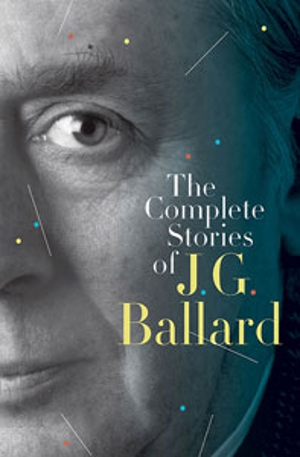 That would be THE COMPLETE SHORT STORIES OF J.G. BALLARD (W.W. Norton). This massive 1216-page volume has been available in the UK for the past couple years, but only made it to these shores following its author’s 2009 death. If you’re unfamiliar with the bizarre, provocative, disarmingly prophetic and thoroughly addictive fiction of J.G. BALLARD (whose writing inspired the films EMPIRE OF THE SUN, CRASH and THE ATROCITY EXHIBITION) than this book, containing every story the great man ever wrote, is a perfect starting point. It’s also ideal for people like me who’ve been scouring used bookstores in an effort to track down Ballard’s stories, some of which are quite elusive. Not anymore!
That would be THE COMPLETE SHORT STORIES OF J.G. BALLARD (W.W. Norton). This massive 1216-page volume has been available in the UK for the past couple years, but only made it to these shores following its author’s 2009 death. If you’re unfamiliar with the bizarre, provocative, disarmingly prophetic and thoroughly addictive fiction of J.G. BALLARD (whose writing inspired the films EMPIRE OF THE SUN, CRASH and THE ATROCITY EXHIBITION) than this book, containing every story the great man ever wrote, is a perfect starting point. It’s also ideal for people like me who’ve been scouring used bookstores in an effort to track down Ballard’s stories, some of which are quite elusive. Not anymore!
Speaking of iconic genre authors, let’s move on to…
The King
STEPHEN KING’S latest novel is UNDER THE DOME (Scribner), a lively and readable 1074-page(!) opus.
The premise is quite simple, positing that a vast invisible enclosure suddenly covers the sleepy community of Chester’s Mills one morning. The dome is impervious to bullets, airplanes and even a missile fired at it from outside, meaning there’s no way out for the unfortunate people trapped within.
Among those caught under the dome are Barbie, an Iraq veteran turned fry cook; Julia, the muckraking editor of the local newspaper; Big Jim, a slimy meth-dealing politician; and Junior, the latter’s psychotic offspring. Also afoot are the dome’s mysterious architects, but this portion is left somewhat murky, as if King realized there was no way to adequately explain his fantastic concept.
There’s also an ecological metaphor, with the air in the dome dirtied by the pollutants released into the enclosed atmosphere. In the end, of course, UNDER THE DOME works simply because it’s fun. King knows how to spin a yarn, and proves that here, providing thrills, scares, some romance, a few scattered laughs and even a message or two.
As for Stephen King’s other 2009 release, STEPHEN KING GOES TO THE MOVIES (Pocket), it’s a bit of a 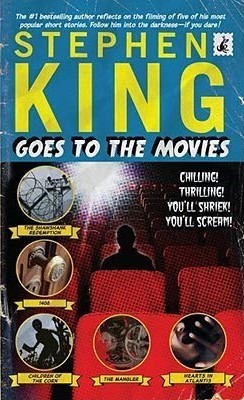 bummer. It consists of five short stories and novellas all readily available elsewhere, with just eleven pages of new material. Those eleven pages consist of King’s thoughts on the films made from the stories—as the title attests, the theme is movies and the fiction that inspired them.
bummer. It consists of five short stories and novellas all readily available elsewhere, with just eleven pages of new material. Those eleven pages consist of King’s thoughts on the films made from the stories—as the title attests, the theme is movies and the fiction that inspired them.
Of those five stories, “The Mangler” and “Children of the Corn” are quite good. So are “Rita Hayworth and the Shawshank Redemption” and “1408.” However, the inclusion of the lengthy first chapter of HEARTS IN ATLANTIS is downright mind-boggling, especially since King claims he was dissatisfied with the film adaptation because it only told a portion of the complete story. So why reprint that portion here? Why not use the space for other worthy King stories that have been made into movies (including “The Mist,” “Apt Pupil” and “The Body”) but don’t appear herein?
My advice? Skip STEPHEN KING GOES TO THE MOVIES and read the other books containing these stories (NIGHT SHIFT, DIFFERENT SEASONS, EVERYTHING’S EVENTUAL and HEARTS IN ATLANTIS).
First-Timers
Seemingly everyone has praised CHRISTOPHER RANSOM’S THE BIRTHING HOUSE (St. Martin’s Press) to the skies, and after reading it I’ll have to say that for once everyone is right. It’s a first novel of uncommon nuance and conviction, with a probing intelligence and depth of characterization that aren’t supposed to be able to co-exist with supernatural scares.
It begins in traditional haunted house fashion, with Conrad Harrison, a disaffected young man, buying a century-old Wisconsin birthing house. Conrad’s wife Joanna doesn’t share his enthusiasm for the abode, and takes a job that whisks her away for several weeks. Thus Conrad is left alone in the birthing house, where he’s given a gift by the previous owner: a vintage photo album packed with moldering pictures of the many pregnant ladies who previously stayed in the place…whose ranks include the glowering face of Conrad’s wife!
Much of the narrative pivots on real world concerns—the pratfalls of adjusting to a new environment, the hardships of dual-income marriages and long distance relationships—alternated with supernatural intrusions that are vivid and disquieting. The novel for the most part qualifies as a work of “quiet” horror marked by a sense of sustained apprehension, yet the climax is a profoundly intense one in which the twin specters of demonic possession and bloody psychosis rise to the fore.
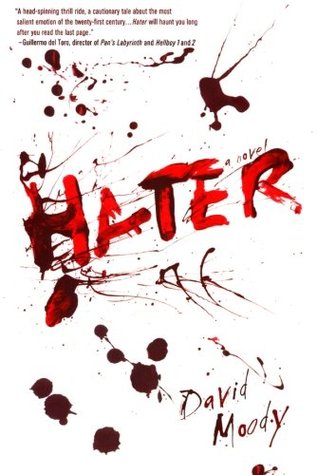 Another standout publication by a debuting novelist was HATER by DAVID MOODY (St. Martin’s Press). It uses the age-old concept of ordinary folks turned into rage-driven killers and actually succeeds in making it seem fresh.
Another standout publication by a debuting novelist was HATER by DAVID MOODY (St. Martin’s Press). It uses the age-old concept of ordinary folks turned into rage-driven killers and actually succeeds in making it seem fresh.
Londoner Danny McCoyne has problems: he’s stuck working in the Parking Fines Processing Office, where irate citizens show up to gripe about getting ticketed or having their car wheels clamped. Danny’s home life isn’t much better, as his wife is a shrew and his two kids are brats. It seems all-too-easy for a guy to go over the edge in such dire circumstances, especially since an epidemic is sweeping London, and apparently the rest of the world, that turns people into remorseless killers—or Haters. But the Haters don’t seem entirely hateful in their aggression, behaving as if they’re the ones being attacked.
The early passages, with their undertones of simmering rage and none-too-quiet desperation, are disarmingly prophetic. A perverse echo occurs in the final chapters, in which a shocking narrative turnaround propels this dark tale into genuinely subversive territory.
For those of you who like your horrific thrillers heavy on the horror, AFRAID (Grand Central Publishing), written by cop thriller specialist J.A. Konrath under the debuting pseudonym JACK KILBORN, is for you. It’s a dark wilderness set freak-out in the mold of David Morrell’s early novels, with five psychotic killers transformed into computer modified Red Ops fighters loosed on a sleepy Northeastern town. Lots and lots of colorful carnage ensues as the psychopaths embark on a veritable carnival of mass slaughter. Not even a squadron of other special forces teams can take them down, leaving it up to a few scattered townspeople to deal with the psychos on their own.
Relentless is the word for this novel, which keeps the tension brewing with nasty killings and show-stopping action set pieces at a rate of about one every page-and-a-half. It’s a fast and compulsive read that’s also genuinely scary: the concept may be on the high side, but it doesn’t seem all that implausible based on the things I’ve heard about the US military and its compulsive implementation of new technologies, many of them of a questionable variety.
A take-no-prisoners gut-punch of a book you won’t soon forget!
Here we come to an epic horror novel marketed as a genre masterpiece that reinvents the vampire mythos for a 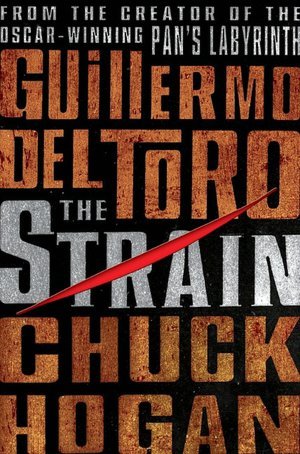 new generation. Is it THE HISTORIAN? Nope. MIDNIGHT MASS? No. THE VAMPIRE TAPESTRY? Not that. INTERVIEW WITH A VAMPIRE? No again. It’s THE STRAIN (William Morrow), the first novel by filmmaker GUILLERMO DEL TORO (although I’m guessing the majority of the text was written by the more experienced co-writer CHUCK LOGAN).
new generation. Is it THE HISTORIAN? Nope. MIDNIGHT MASS? No. THE VAMPIRE TAPESTRY? Not that. INTERVIEW WITH A VAMPIRE? No again. It’s THE STRAIN (William Morrow), the first novel by filmmaker GUILLERMO DEL TORO (although I’m guessing the majority of the text was written by the more experienced co-writer CHUCK LOGAN).
It’s drafted in tried-and-true bestseller fashion, with a myriad of characters caught up in a vampire conflagration that begins when a plane lands in New York City whose pilots and passengers are all apparently dead. In fact they’ve been vampirized, and are set to be the inception of a bloodsucking epidemic that will soon encompass New York City. Leading the anti-vampire resistance are a plucky disease control employee, his ex-wife and a holocaust survivor who’s been tracking the vampires’ leader since first encountering the thing back in the death camps. It all boils down to a violent showdown at the World Trade Center foundation (a.k.a. the “Bathtub”) and a fade-out that leaves ample room for a sequel (THE STRAIN being the first book of a projected trilogy).
The vamps in this novel were conceived in distinctly biological terms, complete with a Cronenbergian tongue attachment that lashes out at people and spreads the disease. An interesting concept, yes, but hardly Earth-shaking. As for the novel overall, it’s not bad by any means, being fast, entertaining and action-packed–but NOT the classic for the ages it’s been made out to be.
Sequels
Among the many sequels that appeared in ‘09 was HEAD GAMES, the second volume of the JOE HILL scripted, GABRIEL RODRIGUEZ illustrated comic series LOCKE AND KEY (IDW). It picks up where 2008’s first installment WELCOME TO LOVECRAFT left off: with the traumatized Locke children attempting to settle into life in the town of Lovecraft(!).
The Lockes still have those neat keys that (as elucidated in WELCOME TO LOVECRAFT) open doors into supernatural realms. Here, though, the keys actually open the tops of the kids’ heads, letting others peer into their private worlds. This is by far the most arresting concept of this volume, and allows illustrator Gabriel Rodriguez—whose bold artwork is stellar—to run riot with phantasmagoric imagery.
The head-opening idea is so cool it dwarfs virtually everything else herein, notably the return of WELCOME TO LOVECRAFT’S psychotic antagonist, who murdered the protagonists’ father and is on the loose once again. The latter has got hold of a time traveling key he uses to make all sorts of trouble, but his exploits are confusing and difficult to follow. The book further suffers from an abrupt and puzzling conclusion (upon reading the words “The End” I was sure it was a joke or misprint). Again, though, HEAD GAMES’ central conceit is a stunner, even if the comic overall doesn’t live up to it.
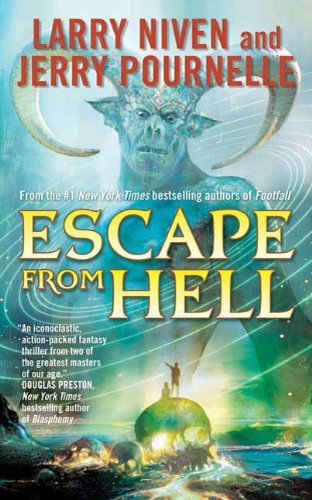 ESCAPE FROM HELL by LARRY NIVEN and JERRY POURNELLE (Tor) is the long-awaited follow-up to Niven and Pournelle’s 1976 classic INFERNO. That book remains an invigorating jaunt through Dante’s Inferno, with the deceased sci fi writer Allen Carpenter traversing the nine circles of Hell, guided by an individual named Benito who eventually reveals himself as none other than Benito Mussolini. Carpenter becomes convinced that Hell is actually a training ground for wayward souls; he proves this (or seems to) by guiding Benito out of Hell, and on the final page heads back to save more souls.
ESCAPE FROM HELL by LARRY NIVEN and JERRY POURNELLE (Tor) is the long-awaited follow-up to Niven and Pournelle’s 1976 classic INFERNO. That book remains an invigorating jaunt through Dante’s Inferno, with the deceased sci fi writer Allen Carpenter traversing the nine circles of Hell, guided by an individual named Benito who eventually reveals himself as none other than Benito Mussolini. Carpenter becomes convinced that Hell is actually a training ground for wayward souls; he proves this (or seems to) by guiding Benito out of Hell, and on the final page heads back to save more souls.
In ESCAPE FROM HELL Carpenter tries to make good on his goal to lead Hell’s denizens out. Doing so entails retracing the path Carpenter took in the original book, reconnecting with many of its cast members and encountering quite a few new obstacles.
The style is virtually identical to that of INFERNO, with the emphasis on action and sensation. ESCAPE, though, is longer than the earlier book, and less cohesive. Billy the Kid returns from INFERNO, as does Lucifer himself. The poet Sylvia Plath (introduced here as a living tree) is also on hand to join Carpenter’s crusade, along with Carl Sagan, Oscar Wilde, Anna Nicole Smith, J. Robert Oppenheimer, Pontius Pilate, and (in a last-minute cameo) Josef Stalin and Adolf Hitler. The 9/11 attacks, the Iraq War and Hurricane Katrina are all alluded to, and while the authors are famous for their conservative views, you may be surprised by their takes on these and other real-life events.
BRIAN LUMLEY’S Necroscope series, commenced in the late eighties and numbering over a dozen volumes, is officially finished, but in NECROSCOPE: HARRY AND THE PIRATES (Tor) Lumley offered three short pieces set during the “Lost Years” of Harry Keogh the Necroscope (i.e. a guy who can talk to the dead). Lumley is an extremely prolific English writer who got his start publishing H.P. Lovecraft-inspired pastiches. He’s retained the Lovecraft influence and the pulpiness that comes with it, as is evident in HARRY AND THE PIRATES.
It begins with “For the Dead Travel Slowly.” In it Harry investigates a series of murders committed by an ancient Cthuloid monstrosity. The tale is overlong and dragged out; we’re informed on the first page who the culprit is, which makes the remainder of the piece something of a waiting game for Harry to figure out what we already know. “Harry and The Pirates” follows, being a witty tribute to the seafaring horror of William Hope Hodgson. Finally there’s a 4-pager called “Old Man with A Blade,” about a certain indistinct man with a long curved blade who views all humanity as potential victims, and is an “old friend” of Harry Keogh…
From Japan
Make no mistake, the Japanese pulp quickie WICKED CITY: BLACK GUARD by HIDEYUCHI KIKUCHI (Seven 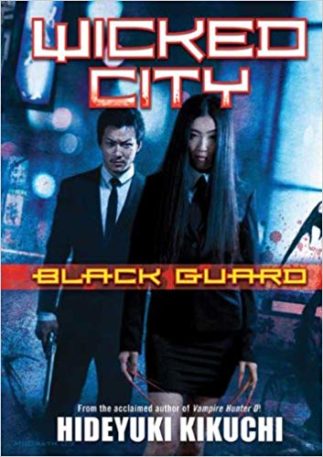 Seas) is complete and utter trash: simple minded, perfunctorily written and wildly misogynistic. Is it any wonder I enjoyed the Hell out of it? (Full Disclosure: I’m a fan of the manga and live action film adapted from this book, and so was primed to like it.)
Seas) is complete and utter trash: simple minded, perfunctorily written and wildly misogynistic. Is it any wonder I enjoyed the Hell out of it? (Full Disclosure: I’m a fan of the manga and live action film adapted from this book, and so was primed to like it.)
Reading like a trashy redo of the Russian WATCH series (NIGHT WATCH, DAY WATCH, etc.), WICKED CITY is about a netherworld of demons whose universe intersects with ours. The demons appear in our reality as sex-mad humans whose flesh melts and metamorphoses in all sorts of freaky ways, leading to lots of arrestingly bizarre H.R. Giger-esque imagery. There’s also a good deal of perversion. The hero, a stiff-lipped “Black Guard” charged with keeping the demons in line, gets down and dirty with the creatures on several occasions, as does his partner, a demon woman who naturally loves being penetrated by anything with a penis.
The author bio equates Hideyuki Kikuchi (best known for the VAMPIRE HUNTER D series) with Stephen King. That’s an extremely generous comparison, but in unpretentious readability and gross-out surrealism Kikuchi excels. Apparently a second WICKED CITY volume is on the way, and I for one can’t wait!
HELL by YASUTAKA TSUTSUI (Alma Press) is a very odd, and very culturally specific, look at Hell. There’s no fire and brimstone in this inferno, which functions as a vast waking dream whose inhabitants are able to move back and forth through time and telepathically experience each other’s thoughts and memories.
The novel interweaves the exploits of several Japanese folk who’ve landed in Hell by flashing back and forth, unexpectedly and seemingly haphazardly, between present and flashback. Among the characters are three men, friends since childhood, and their respective wives and mistresses. There’s also a famous writer and his actress companion (who realize where they are only after a descending elevator they’re trapped in stops on floor 666) and a homeless man who comes to in Hell after freezing to death along with his beloved wife.
Adding to the oddness is Yasutaka Tsutsi’s disarmingly relaxed prose, which relates everything from an intense torture sequence to a seemingly mundane train ride with the same calm, even-handed tone. The novel is short and easy to read, yet a full understanding requires some heavy lifting on the part of the reader. I’m sure this will severely curtail its potential audience. I don’t know that I liked it all that much myself, yet its enigmas did seem worth decoding—or at least pondering.
Anthologies
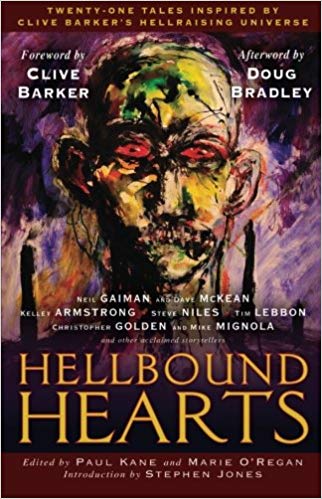 HELLBOUND HEARTS, edited by PAUL KANE and MARIE O’REGAN (Pocket), is an anthology inspired by Clive Barker’s HELLRAISER. With a stable of first-rate authors that include Neil Gaiman, Tim Lebbon, Christopher Golden, Sarah Langan and Gary Braunbeck, you can count on a good read at the very least.
HELLBOUND HEARTS, edited by PAUL KANE and MARIE O’REGAN (Pocket), is an anthology inspired by Clive Barker’s HELLRAISER. With a stable of first-rate authors that include Neil Gaiman, Tim Lebbon, Christopher Golden, Sarah Langan and Gary Braunbeck, you can count on a good read at the very least.
I’m not entirely sure, however, that all the contributors understand what makes the material interesting. Quite a few of these 21 stories have a similar arc: a guy or gal commits some horrific crime out of grandiose ambition, villainy or plain stupidity, and is dragged off to Hell by the monstrous Cenobites in the final pages. Well and good…except for the fact that, as you may recall, that was where HELLRAISER began.
Some of the contributors get it. Mark Morris’ “Mother’s Ruin” is genuinely dark and surprising, concerning a socially maladjusted sad sack with a taste for extremes; needless to add, he gets what he wanted at the hands of the Cenobites! Simon Clark’s riotous “Our Lord of Quarters” is set in Constantinople of 1401, wherein a slave goes up against an ambitious demon, while Gary Braunbeck and Lucy Snyder’s “However…” actually casts the Cenobites as saviors of a sort for a despairing trio of young people suffering untold torture.
The book’s centerpiece, the graphic tale “Wordsworth” written by Neil Gaiman and illustrated by Dave McKean, is a disappointment, but “Prisoners of the Inferno” by Peter Atkins (screenwriter of HELLRAISER 2: HELLBOUND) isn’t. It’s about an obscure film that leads a collector into a deadly universe of ancient evil. Finally there’s Barbie Wilde, who played one of the Cenobites of HELLRAISER 2 and contributes “Sister Cilice,” a potent piece of nunspoloitation. It contains plenty of grotesquerie, and, unlike the majority of the book’s other tales, doesn’t wait until the end to dish it out.
BLANKET OF WHITE (Damnation Books) is another rough and uncompromising collection of stories by AMY GRECH, following 2006’s APPLE OF MY EYE. Many of the stories from that book recur (including goodies like “Damp Wind and Leaves,” “Perishables,” “Rampart,” “Cold Comfort” and “EV 2000”), making this the lesser of the two volumes.
Of the non-reprints, the title story is pitch-perfect in its unflinching exploration of a distraught father’s grief at his daughter’s debilitating cerebral palsy, and the “extraordinary gift” he gives her. Another stand-out is “Come and Gone,” a distinctly carnal evocation of longing and memory with generous helpings of sex, masturbation and bloodletting.
“Russian Roulette” is about the violent revenge enacted by a murdered woman’s ex husband. It contains some potent shocks, although the arc is predictable. “Crosshairs” is better, being a grim account of a boy who takes his father’s advice about hunting a little too far. Less nasty is “Ashes to Ashes,” an unexpectedly tender tale of a woman’s attempts at coming to terms with the death of her husband. Good stuff, but again, most of the rest of BLANKET OF WHITE consists of contents from APPLE OF MY EYE, meaning you might as well read that book in place of this one.
AROUND A DARK CORNER by JEANI RECTOR (Turner Maxwell Books) followed fast on the heels of Ms. 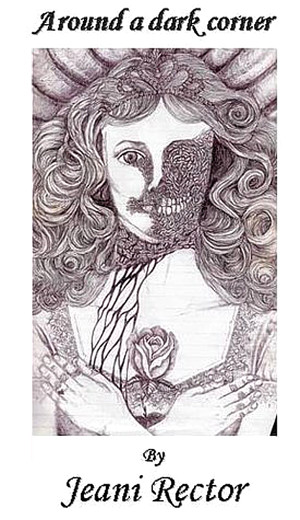 Rector’s previous collection OPEN GRAVE. That book for me remains her most resonant, but AROUND A DARK CORNER made quite an impression.
Rector’s previous collection OPEN GRAVE. That book for me remains her most resonant, but AROUND A DARK CORNER made quite an impression.
“The Dead Man” starts things off, consisting largely of a protracted description of the dismemberment of a corpse. “A Medieval Tale of Plague” follows, an impeccably researched account of a young woman’s nightmarish existence in plague-ridden London.
Taken together, the above stories are good indicators of this book’s considerable range. It contains a tale of demonic invocation (“The Spirit of Death”), a peek into the mind of murderous psychopath (“Horrorscope”), a trickily structured werewolf story (“In Any Language”), an account of a man with a maggot fetish (“Maggots”), and an uncomfortably intimate description of a plane crash (“Flight 529”).
The final entries are two longish tales, “Lady Cop” and “A Teenage Ghost Story.” The first is a compelling study of a rookie cop’s brutal induction into some of the uglier realities of her profession. The second is a gentle look at two teen girls thrust into an age-old mystery that’s vaguely reminiscent of the young adult novels of Richard Peck. It all adds up to another memorable volume by an author I’m confident will become a major voice in the field.
MAGICK AND MISERY by LINCOLN CRISLER (Black Bed Sheet Books) collects eleven short pieces by a three-time Iraq War veteran. This explains the impact of these ostensibly escapist tales, which aren’t unusually graphic or excessive but have a kick missing from much of today’s horror.
Perhaps I’m wrong in contrasting Lincoln Crisler’s combat experiences with his fiction. None of the contents of MAGICK AND MISERY explicitly deal with war, yet its specter is present in “Making the Grade,” about a schoolboy whose parents literally bet his life on his usefulness to a corrupt government, and “Old Stooping Lugh,” a bloody tale of Irish mobsters and a demon marked by copious gunplay and explosions.
Violent death is a common element. It’s present in the perverse Isaac Asimov pastiche “Seymour’s Descent,” about a robot that learns to kill—and enjoys it! It recurs in “Devotion,” in which a man attempts to rescind his infidelity to his beloved wife in profoundly sick fashion.
Another stand-out is “Pete Does What Needs to be Done.” In this sickie a runaway boy gets back at his hated parents by faking a kidnapping, enhanced by amputating his own hand and mailing it to ’em! “The Gambler,” by contrast, is a touching account of a traumatized man’s train-bound meeting with an ex-hobo who’s experienced his own share of trauma.
A fine collection, well worth your time!
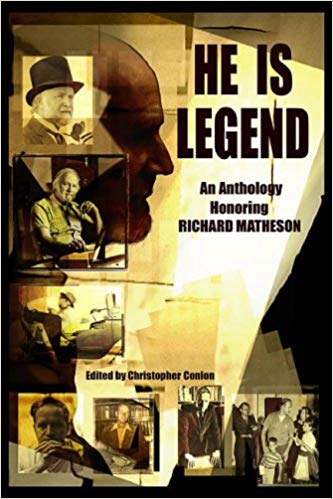 I’ll confess I didn’t read all of Gauntlet Press’ CHRISTOPHER CONLON edited anthology HE IS LEGEND, consisting of all-new stories by famous authors inspired by the fiction of Richard Matheson. I didn’t bother with Whitley Streiber’s entry or Matheson’s screenplay adaptation of Fritz Leiber’s CONJURE WIFE (which concludes this book). However, I did peruse much of the rest of the collection, and found it solid. Not great, but solid.
I’ll confess I didn’t read all of Gauntlet Press’ CHRISTOPHER CONLON edited anthology HE IS LEGEND, consisting of all-new stories by famous authors inspired by the fiction of Richard Matheson. I didn’t bother with Whitley Streiber’s entry or Matheson’s screenplay adaptation of Fritz Leiber’s CONJURE WIFE (which concludes this book). However, I did peruse much of the rest of the collection, and found it solid. Not great, but solid.
The book’s claim to fame is “Throttle,” the first-ever collaboration between Stephen King and son Joe Hill. It’s a fine, gritty take on Matheson’s DUEL, with the lone motorist of the original replaced with a motorcycle gang.
Other standout tales include “Return to Hell House,” in which Nancy Collins wreaks some perverse twists on Matheson’s HELL HOUSE; John Shirley’s “Two Shots from Fly’s Photo Gallery,” which uses the time travel conceit of SOMEWHERE IN TIME for a western tale; and Joe Lansdale’s “Quarry,” a fun sequel to the legendary evil doll story “Prey.” Also worthy of mention is “The Diary of Louise Carey” by Thomas F. Monteleone, which characterizes the underdeveloped character of the protagonist’s wife in THE SHRINKING MAN as a scheming bitch!
Here I’ll take a look at the 2009 offerings of various genre publishers, starting with my pick for the year’s Coolest Publisher:
Leisure
Leisure, as it has for the past several years, put out several vital novels in affordable paperback editions. Among its 2009 output was a reprint of JACK KETCHUM’S 1987 roughie COVER. It’s one of Ketchum’s better efforts, a superbly spare and suspenseful account of a homicidal Vietnam veteran loose in the American wilderness with six innocent people in his crosshairs.
Beyond that I’ll say this about COVER: it’s directly responsible for me dropping a biology course. This is to say that back in my college days I made the mistake of starting the book the night before an important exam in said biology course, and was unable to put the damn thing down!
The newest effort from the pioneering splatmeister JOHN SKIPP was JAKE’S WAKE, written in collaboration with 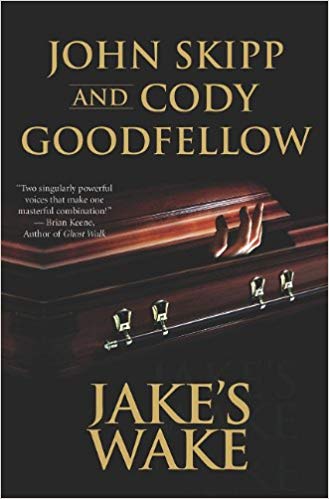 CODY LONGFELLOW. Like Skipp’s previous novel THE LONG LAST CALL, JAKE’S WAKE was initially intended as a movie; this explains the contained nature of the action, which takes place over the course of a single night.
CODY LONGFELLOW. Like Skipp’s previous novel THE LONG LAST CALL, JAKE’S WAKE was initially intended as a movie; this explains the contained nature of the action, which takes place over the course of a single night.
The title character is a con man preacher whose innumerable sins include whoring, lying, embezzlement and all manner of general assholery. Fortunately for his parishioners, Jake has just died…but then he inexplicably springs back to life and embarks on a rampage. The narrative from there on is largely taken up with a minute-by-minute description of the mayhem that ensues, which includes forced incarceration, eyeball gouging, a crucifixion, a ROAD WARRIOR-esque highway pile-up and a final apocalyptic twist.
It’s nasty, thrill-a-minute fun for the most part, drafted in Skipp’s standard hip and profane style. But as the subversive commentary on modern religion the authors were evidently shooting for the novel falls short. Its biggest problem is that Jake, the lynchpin of that commentary, is an overly one-dimensional scumbag, essentially a stew of meanness and sarcasm in search of a character. Thus JAKE’S WAKE, enjoyable though it is, never reaches its full potential.
WRATH JAMES WHITE is very likely the nastiest, most unflinching horror writer at work today. THE RESURRECTIONIST is far from the most graphic of his works, but it is very likely the most mature.
Its subject is Dale, an antisocial psychopath with the “gift” of resurrecting the dead, thus allowing him to kill people and then revive them. The author’s true concern, however, is the trauma faced by those on the receiving end of Dale’s psychosis.
The protagonist is Sarah, who’s fated to live across the street from Dale, and who he rapes and mutilates each night, followed by the inevitable resurrection. Sarah always comes to with no memory of the horror, yet the psychic scars left by Dale’s evil are evident and unmistakable.
The violence here is graphic, certainly, and at times downright nauseating (particularly toward the end, which contains a novel variant on the term skull-fucking), but there’s far less of it than in most of Wrath’s previous novels and stories. This makes for a less exciting and disturbing read than POISONING EROS or SUCCULENT PREY, but what THE RESURRECTIONIST lacks in grue it makes up for in empathy and wisdom.
Night Shade Press
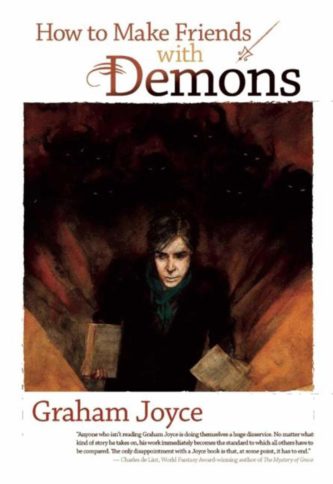 Of the two Night Shade Press releases I read in 2009, the unquestioned standout was HOW TO MAKE FRIENDS WITH DEMONS. It’s one of the most unique efforts of the brilliant GRAHAM JOYCE, who provides a nontraditional character study centered on William Heaney, a middle-aged government worker who can see demons. William, you see, conducted a weird occult ritual in college that exposed him to the realm of the demonic.
Of the two Night Shade Press releases I read in 2009, the unquestioned standout was HOW TO MAKE FRIENDS WITH DEMONS. It’s one of the most unique efforts of the brilliant GRAHAM JOYCE, who provides a nontraditional character study centered on William Heaney, a middle-aged government worker who can see demons. William, you see, conducted a weird occult ritual in college that exposed him to the realm of the demonic.
The narrative has numerous strands that advance concurrently, with flashbacks of William’s college-era exploits being one of them. Another concerns his present activities, which include preparing a forged first edition of PRIDE AND PREJUDICE and puzzling over the affections of a young woman who for some unfathomable reason seems interested in William. And then there are the demons, which are ever-present and not about to go away.
All of this initially seems disjointed, but Joyce gradually draws it together into what turns out to be a carefully structured account. Thus we have a novel that’s witty, chilling and every bit as complex and multi-faceted as its impeccably sketched protagonist.
I was considerably less enamored of THE MALL OF CTHULHU by SEAMUS COOPER. I found this novel quite reminiscent of William Browning Spencer’s RESUME WITH MONSTERS, and believe me, the comparison does MALL OF CTHULHU no favors.
It concerns the dorky Ted, who’s stuck laboring in a corporate coffee chain in Boston. Ted has an impressive pedigree, having single-handedly killed a gaggle of vampires years earlier. Ted’s monster-killing skills are called back into play when a nut shoots up his workplace, leading Ted to a Cthulhu worshipping cult looking to resurrect the “Old Ones” in a shopping mall located in Providence, RI (where Cthulhu’s creator H.P. Lovecraft resided).
The whole thing is lightweight to the point of transparency, and not a little dumb. Comedy and horror aren’t an especially easy combination to pull off in novels, as MALL OF CTHULHU proves. Also, you’ll need more than a passing familiarity with H.P. Lovecraft’s Cthulhu Mythos to fully comprehend this novel—but then, even for those who know their way around Lovecraft’s mythology (i.e. me) this is a so-so book at best.
PS Publishing
The UK-based PS Publishing is at the forefront of independent genre publishing. PS’s standout ‘09 releases 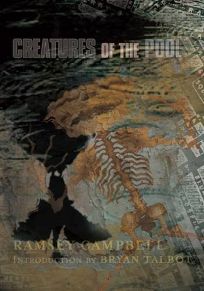 include CREATURES OF THE POOL, the latest novel by the inimitable RAMSEY CAMPBELL.
include CREATURES OF THE POOL, the latest novel by the inimitable RAMSEY CAMPBELL.
The first-person point of view of this highly atmospheric tale is that of the jittery Gavin Meadows. He gives guided tours of the “Pool” of the title, specifically Liverpool. Gavin, like Liverpool native Ramsey Campbell, knows the locale inside and out, and his knowledge extends to the legends and folklore of the area—which, as he gradually discovers, may not be entirely legendary. But then again Gavin could well be losing his mind, judging from the spectral forms he always thinks he’s seeing and the ceaseless water imagery that pervades his existence.
The constant reality displacement is unnerving, particularly since, this being a first-person account, we have no way of objectively gauging how reliable Gavin’s viewpoint is. Obviously his paranoia, suspicion and employment hassles aren’t enough to sustain a novel, whose main thrust is provided by the disappearance of Gavin’s eccentric father. Even this development, however, is open to interpretation: is the old guy truly lost/kidnapped or is this another of Gavin’s delusions? This is the most Dan Brownish of Campbell’s novels, with hints of a vast conspiracy and a cliffhanger at the end of every chapter. So the book, which suffers from a repetitive and inconclusive narrative, is at least quite readable.
Also from PS was a new work by the great T.M. WRIGHT entitled BLUE CANOE. Blindingly eerie and poetic, it’s a rare example of Wright at his most unrestrained.
There’s an odd man named Happy Farmer who resides in a large house by a lake and is obsessed with “the town named after the lake,” accessible by a blue canoe. In the meantime Happy is bothered by the voices of the house’s (apparently) numerous other residents and a dog he dubs “the-dog-who-would-have-been-Bob-had-he-been-Bob.”
Also afoot is a woman named Epistobel who may be a ghost or delusional phantasm. Happy himself is nearly as incorporeal, and the precise realit(ies) being depicted are constantly open to question, especially when, shortly past the halfway mark, a new protagonist enters the story: Andrew Grimm, a death-obsessed young man attempting to track down his estranged lover with the help of an equally eccentric Private Dick named Fred Spoon. Andrew and/or Fred may actually be Happy in a previous life…or perhaps not.
For that matter, the tale overall could be the memoir of an incarcerated madman or a ghost. As in all his 31-plus books, what Wright is truly after, in his own surreal, poetic fashion, are the emotions behind the scenery: the love, fear and anxiety his characters—and by extension his readers—experience.
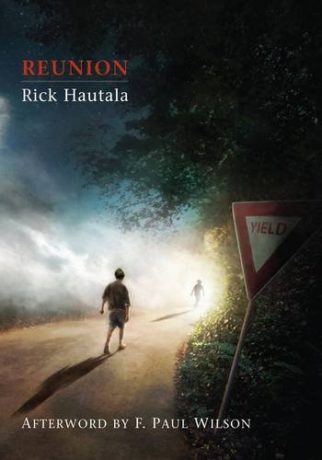 RICK HAUTALA isn’t one of my favorite writers, but I can’t deny that he knows how to spin a yarn. Hautala proves that in REUNION, a fast moving page-turner that can be taken as a straightforward sci fi-tinged chiller or (as F. Paul Wilson suggests in his afterward) a deep, meaningful exploration of loss and longing.
RICK HAUTALA isn’t one of my favorite writers, but I can’t deny that he knows how to spin a yarn. Hautala proves that in REUNION, a fast moving page-turner that can be taken as a straightforward sci fi-tinged chiller or (as F. Paul Wilson suggests in his afterward) a deep, meaningful exploration of loss and longing.
REUNION contains some of Hautala’s shortcomings, notably an overabundance of clichés: a blown tire is “flat as a pancake” and there are several variations on that ever-popular genre standby, the icy chill felt at the base of one’s spine. For the most part, though, it’s quite good, and at 111 pages is the only Hautala book I’ve read that I don’t feel is too long (this is an author whose novels tend to clock in around 500 pages).
The tale begins in a small Northeastern town where the introspective young Jackie and his troublemaking buddy Chris intend to crash a nighttime high school reunion. Also afoot in the area is the fiftyish John, who’s traveled all the way from California to attend the reunion. It’s clear from the start that John’s intentions involve Jackie and Chris, both of whom he somehow knows intimately. What ultimately occurs is scary, sad and thought-provoking, with a not-inconsiderable emotional impact.
If any type of literature can truly be called critic-proof it’s surrealism, which deliberately violates any number of hard-and-fast rules of structure and composition, and doesn’t even have to—shouldn’t, in fact—make sense. To make a distinction as to whether such writing is good or bad is purely a matter of intuition. With that in mind, I’ll have to say that based on the nine surreal tales collected in GLASS COFFIN GIRLS, author PAUL JESSUP definitely has the touch. Each story reads like it was plucked directly from its author’s subconscious, with prose that’s crisp and direct.
“Secret in the House of Smiles” starts the book off in typically atypical fashion with Jack, a nutty college dude who likes to cut out pieces of women’s bodies from magazines and paste them together in new configurations, and his vampire (quantum vampire, that is) hunting girlfriend Alice. Equally representative is the title story, a nutty take on traditional fairy tale themes involving a cannibal princess, a dog that walks on two legs and a literal glass coffin.
I’m not entirely sure what to make of “Wire Rabbit,” which for much of its length reads like an acid trip rewrite of Richard Matheson’s classic “Born of Man and Woman.” I’m also a little unclear on the final story “It Tasted Like the Sea,” a troubling account of an artist serial killer told from the point of view of his traumatized girlfriend, who tries to escape into a world of fantasy (that’s how I interpreted it, at least).
ENEMY OF THE GOOD: POSTSCRIPTS 19 is a recent installment of the PETER CROWTHER/NICK GEVERS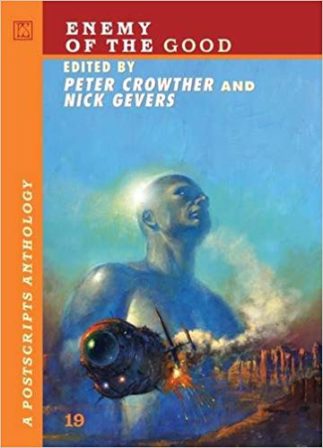 edited POSTSCRIPTS anthology series, showcasing horror, science fiction and the unclassifiable (installments 20 and 21 also followed in ‘09, but I didn’t get to them).
edited POSTSCRIPTS anthology series, showcasing horror, science fiction and the unclassifiable (installments 20 and 21 also followed in ‘09, but I didn’t get to them).
Daniel Abraham starts things off with the rip-roaring steam punk offering “Balfour and Meriwether in the Adventure of The Emperor’s Vengeance.” Following is Andrew Hook’s enjoyable “Bigger Then The Beetles,” about synthetic frogs that grow really, really big when placed in water. Scott Edelman’s “The World Breaks” is a bleak look at America in the wake of a nuclear war, related entirely through letters.
“The Portrayed Man” by Justin Cartaginese has a terrific TWILIGHT ZONE-ish premise but an unsatisfying ending, while the title story by Matthew Hughes is a lengthy science fiction piece involving interstellar thieves and a long-vanished cult. Chris Beckett’s “The Famous Cave Paintings on Isolus 9” concerns a distant planet and a series of cave paintings that lead to intriguing speculations on the nature of religion and reality.
“Famous People” by Ron Savage is notable for its thoughtful and all-too-realistic look at the pratfalls of stardom. “The Cacto Skeleton” by David T. Wilbanks has a walking skeleton whose touch causes people to die, and “The Red King’s Sleep” by Marly Youmans is a wild, unclassifiable dream tale. The final story is “The Warlock and the Man” by M.K. Hobson, which reads like the NIGHT WATCH books/movies transposed to Wild West America. A good story, and also a good book.
These days it’s become chic to feature the likes of Edgar Allan Poe, Arthur Conan Doyle and H.P. Lovecraft as protagonists of yarns that could have sprung from those writers’ own imaginations. GILBERT AND EDGAR ON MARS by ERIC BROWN is the first such account headlined by G.K. Chesterton, the early 20th Century English literary legend.
It begins with Chesterton lured into a portal that deposits him on Mars. He’s quickly rescued by a burly American named Edgar—Edgar Rice Burroughs to be exact, creator of Tarzan and John Carter of Mars. The latter makes an appearance herein as “a famed and feared warlord” Edgar is looking to enlist in the fight against the “Six Philosophers.” The so-called Philosophers have very definite plans for Gilbert and Edgar, who, it transpires, aren’t the first famous writers snatched from the green planet.
GILBERT AND EDGAR ON MARS is a spirited romp, opulently written and full of old world charm. It references Mars-friendly writers like Ray Bradbury and Philip K. Dick as well as the fiction of its reality-based protagonists, and does so without sacrificing the sense of fun and adventure that’s part and parcel to all good pulp fiction.
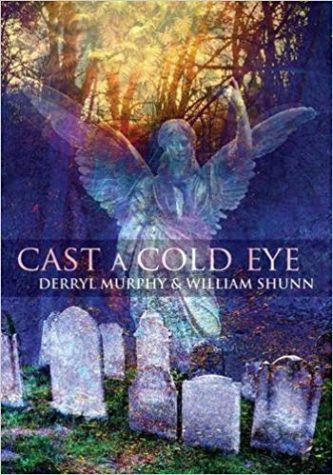 CAST A COLD EYE by DERRYL MURPHY and WILLIAM SHUNN is a novella set during an important but little-explored stretch of American history.
CAST A COLD EYE by DERRYL MURPHY and WILLIAM SHUNN is a novella set during an important but little-explored stretch of American history.
The setting is rural Nebraska circa 1921, a region devastated by Spanish flu. Among the flu’s victims are the mother and father of the story’s protagonist, 15-year-old Luke Bryant, who’s having trouble adjusting to life as an orphan—worse, he always sees graveyard statues open their stony eyes and watch him every time he sets foot in the local boneyard.
Luke’s mental state isn’t helped when he’s made the apprentice of Annabelle Tupper, a spirit photographer. Annabelle initially seems like a charlatan, at least until her true mission is revealed: she’s desperately following the trail of her deceased husband’s wandering spirit. In Luke she’s found an ideal conduit into the spirit world, as ghosts seem drawn to him, and can always be counted on to show up in the photos he takes.
I think the conclusion ties everything up a little too neatly, with Luke and Annabelle finally getting a chance to face up to and put their respective ghosts to rest, and learning an important lesson in the process. It’s very Hollywood, and in direct contrast to the rest of the story, which works largely because of its richness and unpredictability.
Bad Moon Books
First up from the illustrious Bad Moon Books was AS FATE WOULD HAVE IT by MICHAEL LOUIS CALVILLO. Calvillo’s first novel, 2007’s I WILL RISE, heralded the arrival of a vastly unpredictable talent. Calvillo’s second novel AS FATE WOULD HAVE IT more than confirms that promise.
It’s a love story of sorts. On the one hand we have Ashley, a hardened young woman nursing an unwanted heroin addiction. On the other is Montgomery, a chef burdened with an all-consuming addiction of his own: cannibalism. It’s Montgomery’s “problem” that connects these two individuals in the form of Heather, Ashley’s best friend and Montgomery’s latest meal. Once Heather goes missing it doesn’t take Ashley long to deduce the most likely culprit in her disappearance—Montgomery—and track him down. Montgomery is determined to put a permanent end to his cannibalistic tendencies, but figures that with Ashley’s nosiness he might have to break that resolution.
That’s an admittedly thin narrative, but the emphasis from the start is on character development. Be forewarned, though: this book plays rough, particularly in the deeply shocking climax wherein some profoundly nasty surprises wait. The denouement is dark, and extremely so, but also oddly revelatory, literate and provocative. Not unlike the book as a whole.
Regarding SHADOW OF THE DARK ANGEL by GENE O’NEILL, I’m not sure we really need another serial killer 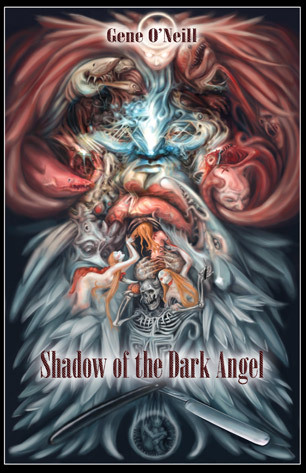 novel. It only reinforces my view that this subgenre has long since been done to death by the likes of Shane Stevens, Thomas Harris, Rex Miller, etc.
novel. It only reinforces my view that this subgenre has long since been done to death by the likes of Shane Stevens, Thomas Harris, Rex Miller, etc.
Once again we’re introduced to a human monster, hideously abused as a child and now on a misogynistic killing rampage. Once again a determined law enforcement officer—a feisty woman, following in the footsteps of SILENCE OF THE LAMBS’ Clarice Starling, KISS THE GIRLS’ Kate McTiernan and THE BONE COLLECTOR’S Amelia Donaghy—is hell-bent on tracking the killer down. Once again it all comes down to a cop-killer mano-a-mano, and an extremely hackneyed one (I wouldn’t dream of revealing who wins).
The unnervingly calm, present-tense prose conveys a sense of lurking menace, especially in the chapters told (in the second person) from the killer’s point of view. Unfortunately the story fails to deliver upon that menace, being a clumsy reinvention of a wheel that’s already been built, ridden and worn clean.
Thankfully Mr. O’Neill also gave us DOC GOOD’S TRAVELING SHOW, an intriguing and absorbing novella set in a minutely detailed future world with a scope that borders on epic. It’s only 83 pages, yet never feels the slightest bit rushed or compressed.
The story begins in “post-collapse” California near the “San Fran” ruins. There 22-year-old Drake and his mute younger brother Littlejoe are looking for employment with a traveling magic show manned by one Doc Good. Drake and Littlejoe’s not-entirely-illusory “illusions” (we don’t learn until the final pages the true nature of D & L’s tricks) become a big hit with the traveling show’s patrons but prove controversial among its performers, some of whom believe the boys are in league with Satan. There’s further trouble on the horizon, leading to a sacrifice—a considerable one—and a daring subterfuge.
It’s a mighty rare case when a novella contains a bit of everything, but this one comes close. It’s tight, lively and fulfilling, not unlike a gourmet meal served in a single course.
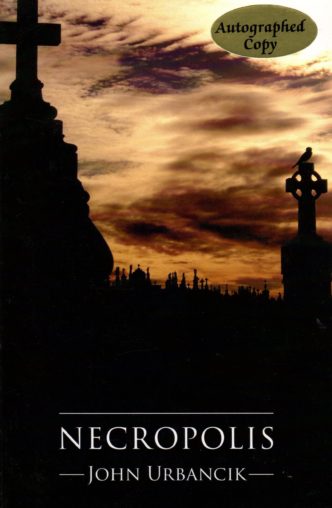 NECROPOLIS by JOHN URBANCIK is an extended prose poem masquerading as a horror novella, a wondrously strange, occasionally gruesome tale.
NECROPOLIS by JOHN URBANCIK is an extended prose poem masquerading as a horror novella, a wondrously strange, occasionally gruesome tale.
In the midst of a vast cemetery several eccentric individuals are caught up in a drama involving murder, sacrifice, capture and escape. There’s Kelli, a photographer lured into the cemetery by an unseen flute player; Kevin and Jill, a couple in search of a wishing well; and Anna and Darren, who are looking to perform a magical incantation.
There’s also a ghostly individual named Auguste and a malevolent entity known as the Spider-Queen, who’s looking for her next meal!
The overall nature of these peoples’ shared predicament isn’t exactly hard to figure out, although John Urbanicik’s aims aren’t as cut and dried as they might seem. As one character comments, “Death comes in layers…you cross one just by being at the cemetery.” Hence the increasingly surreal exploits of Kelli, Kevin, Jill, Anna and Darren.
NECROPOLIS contains some good creepy-crawly stuff, but its real virtues are in the dreamlike atmosphere and thoughtful narrative. The prose is engagingly frank and down-to-Earth, ensuring a one-sitting read for readers unafraid of fine writing that demands much and rewards more.
Fans of the British horrormeister SIMON CLARK will likely appreciate his new novella THIS GHOSTING TIDE, which deals with a psychic wave called a “Ghosting Tide” that sweeps the land and causes the dead to rise. But that’s just one of several ideas warring for prominence in a book that never quite coalesces into a satisfying whole.
It centers on a colorful group of British ghost hunters investigating an apparently haunted beachfront home, but they’ve barely begun setting up their equipment when the Ghosting Tide hits and a bunch of slaughtered rabbits painfully return to life. Where the tale goes from there I won’t reveal, except to say that a development occurs that’s so out of left field it might as well have emerged from an entirely different book.
What follows has a certain B-movie energy, with some diverting grossness (what is “corpse gloop?”) and a second sweep by the Ghosting Tide, which this time is far deadlier than before. The disappointing ending, however, seems on loan from a bad movie.
The concept of time travel is given a fascinating workout in THE GRAY ZONE by JOHN R. LITTLE, a powerfully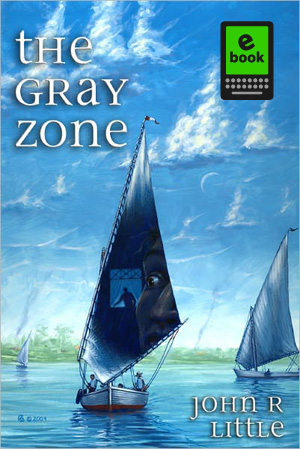 ominous tale superbly drafted in pointed and precise prose.
ominous tale superbly drafted in pointed and precise prose.
It begins in Egypt, circa 1984, where the protagonist Henry saves a young boy from drowning and is rewarded by the boy’s father, who gives Henry a powder apparently filched from the tomb of Ramses II, the “King of Time.” Henry imbibes the powder and is abruptly thrust back to Montreal of 1982.
This is the beginning of a time-tripping odyssey that takes Henry to a high point of his childhood and then into the future year 2002. Before long Henry comes to find the constant jumping between past and future routine. However, there is a point Henry can’t seem to penetrate, a “Gray Zone” in the year 2014. Inevitably Henry finds himself in that Gray Zone, of which no past or future memory exists. That fact is significant because what occurs is profoundly horrific and, even worse, can be experienced again and again, each time with all prior knowledge of the event wiped clean.
THE GRAY ZONE introduces a new concept in time travel fiction, which usually involves people wanting to change the past. This is the first such account I’ve read whose hero is content to experience his past and future as one might a favorite movie—until he’s confronted with something that completely shatters his complacency. One of the year’s best and most thought-provoking books!
The final entry from Bad Moon was THE LUCID DREAMING by LISA MORTON. In this lively 86-page novella humanity is overrun by a plague that causes people to dream while awake. The first person heroine, a trash-talking young woman named Spike, is a paranoid schizophrenic with delusions of grandeur. Spike starts out locked in an Oxnard mental hospital—largely because, she claims, she told her superiors she wanted to be President of the United States—but promptly busts out.
She picks up a “new age freakazoid” named Teddy, and the two make their way through Beverly Hills, Arizona and New Mexico, only to be halted in “Fucking Texas” by a family of redneck assholes. The story takes an altogether unexpected turn at this point, with Spike actually settling down (in a manner of speaking) for a time.
I appreciated Spike’s sassy, world-weary point of view, which lends the perversely ironic culmination of her odyssey a satisfying resonance. Without giving anything away, I’ll reveal that Spike does (sort of) get what she wants, leading to one of the most memorable final lines I’ve encountered in some time.
Creation Books
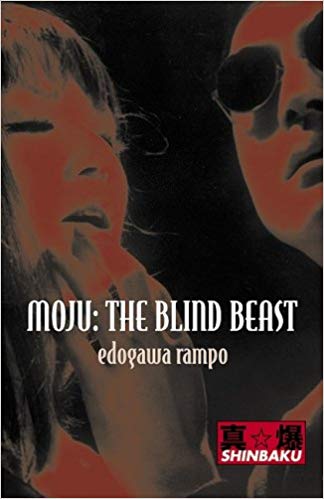 The UK’s Creation Books isn’t an especially prolific publisher, but their books are definitely worth waiting for. In 2009 Creation put out the first-ever English version of EDOGAWA RAMPO’S 1932 classic MOJU: THE BLIND BEAST under their Shimbaku imprint.
The UK’s Creation Books isn’t an especially prolific publisher, but their books are definitely worth waiting for. In 2009 Creation put out the first-ever English version of EDOGAWA RAMPO’S 1932 classic MOJU: THE BLIND BEAST under their Shimbaku imprint.
The protagonist is an ugly-as-sin blind man who’s learned to subsume his every desire into the act of touching women’s bodies. He creates a vast exhibit consisting of lifelike body part sculptures—eyes, noses, nipples, etc.—all contained within a claustrophobic underground room. But the blind man inevitably tires of his sculptures, and so kidnaps the alluring model Ranko. The blind beast shuts her away in the underground room, and the two become enmeshed in an increasingly psychotic morass of desire and madness until the blind man inevitably kills Ranko.
Much of the remainder of the story follows the blind beast as he ensnares subsequent victims. His services as a masseuse become quite popular among the local female populace, and the blind man manages to lure several women into his sculpture room for further banquets of perversion and dismemberment.
Yes, the whole thing is every bit as arrestingly bizarre as it sounds. You can also be sure that Edogawa Rampo’s conviction and narrative savvy hold it together. His fevered imagination and tight prose (ably translated by Anthony Whyte) add up to a wholly unique reading experience at once artful and sleazy.
TEENAGE TIMBERWOLVES: LUST FOR LIGHTNING by JAMES HAVOC and DANIELE SERRA is a relentless psychotic nightmare in the form of a graphic novel. Its headliner is Billy the Wolf Boy, a homicidal shape-shifter reincarnated from a depraved 18th Century French libertine. In his latest incarnation Billy is a lightning-addicted graveyard-dweller who runs with a crowd known as the Teenage Timberwolves, whose ranks include Caril, Billy’s like-minded girlfriend, and Yuki, a Samurai trained Japanese woman turned paid assassin for the Hell’s Angles.
This unspeakably demented epic also features a serial killer who’s declared war on women after having his left testicle devoured by a whore, radical feminists residing in a house made of men’s putrefied eyeballs, and what may be the first and only depiction I’ve encountered of electric chair sex.
James Havoc is among the most extreme writers there is, and has reemerged after a decade of inactivity with this unforgettable work, stunningly visualized by Daniele Serra. The stream-of-consciousness narrative freely incorporates poetry, innumerable cultural and historical touchstones, and a greater succession of depraved acts than any sane person could possibly conjecture. The colorful and appropriately slip-streamy artwork all-but drips dementia, with nearly every page literally spattered with blood. Obviously this volume isn’t for everybody, but for those of you who can appreciate a work of extreme psychosexual imagination pushed to its absolute breaking point, welcome to Nirvana.
Bizarro
The “Bizarro” fiction movement kicked into overdrive in 2009. One of its standout releases was the dark-humored 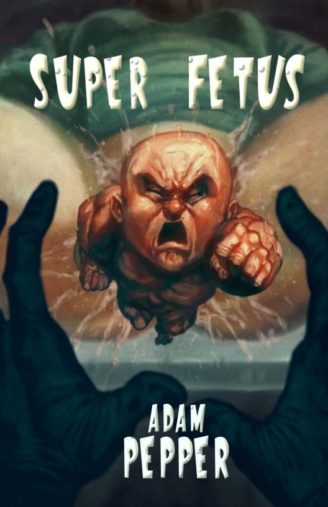 SUPER FETUS by ADAM PEPPER (Eraserhead Press). Predicated on the idea that “there simply aren’t enough positive role models for our young, developing fetuses today,” the narrative pivots on an unborn male fetus who discovers, to its great annoyance, that its mother wants it aborted.
SUPER FETUS by ADAM PEPPER (Eraserhead Press). Predicated on the idea that “there simply aren’t enough positive role models for our young, developing fetuses today,” the narrative pivots on an unborn male fetus who discovers, to its great annoyance, that its mother wants it aborted.
That mother, one Sue Ellen, is a white trash-to-the-nth-power bitch stuck with three kids. She doesn’t want a fourth rug rat, and attempts to have it removed—the fetus itself, however, has no intention of leaving its mother’s womb. An irrepressible trash talker (like mother like fetus), it christens itself “Super Fetus” and takes to working out so it can withstand the force of the abortionists’ tools.
The opening pages, contrasting the fed-up fetus’s first-person observations—“Wah. Wah. Wah. Bitch. Bitch. Bitch…For ten fucking months now I’ve been listening to this!”—with its mother trying to shower while one of her brats pisses on the floor nearby, adequately set the tone. If you flinch here I strongly doubt you’ll enjoy the rest of this novella, which includes generous doses of graphic sexuality, foul language and general bad behavior by a cast of uniformly vile and moronic characters.
THE ASS GOBLINS OF AUSCHWITZ by CAMERON PIERCE (Eraserhead Press) is a typical Bizarro offering, being a freewheeling novella-length account of an alternate universe holocaust where children are snatched from an enchanted land by Nazi Ass Goblins (so named because their torsos consist of giant asses with eyestalks). The kids are imprisoned in Auschwitz, where they’re put to work making toys and bicycles (whose tires are made of brains) while undergoing all manner of torture at the hands of the Ass Goblins; atrocities include being forced to eat the faces of murdered children and anal invasion by horny toilet toads. The protagonist, one half of a pair of conjoined twins, eventually leads a revolution against the Ass Goblins, and in the process meets the most hideous monstrosity of all: Adolph Hitler!
ASS GOBLINS begins in interesting and compelling fashion but fizzles out entirely by the end—and no, it’s never as offensive or disturbing as you might expect given the subject matter, reading like nothing so much as LORD HORROR LITE.
 Another recent Bizarro publication is BRADLEY SANDS IS A DICK (Bust Down the Door and Eat All the Chickens), a 44-page anthology of short (as in 1-3 pages) stories by several members of the Bizarro cartel, edited by ANDERSON PRUNTY and BRADLEY SANDS. All the tales are titled “Bradley Sands is a Dick,” and all are (or at least were apparently supposed to be) about one Bradley Sands, and how/why he’s a dick.
Another recent Bizarro publication is BRADLEY SANDS IS A DICK (Bust Down the Door and Eat All the Chickens), a 44-page anthology of short (as in 1-3 pages) stories by several members of the Bizarro cartel, edited by ANDERSON PRUNTY and BRADLEY SANDS. All the tales are titled “Bradley Sands is a Dick,” and all are (or at least were apparently supposed to be) about one Bradley Sands, and how/why he’s a dick.
The contents are certainly bizarre, but also excessively in-jokey and self satisfied. My favorite stories were those by Jordan Krall (who imagines Mr. Sands as the resurrected corpse of William Burroughs), Carlton Mellick III (in which Brad instigates an epidemic of noses growing out of peoples’ asses), Garrett Cook (in whose tale Bradley Sands does indeed turn out to be a giant penis), and Katy Wimhurst (who somehow manages to drag Milan Kundera and Alfred Jarry into her account).
Nonfiction
MORBID CURIOSITY CURES THE BLUES, edited By LOREN RHOADS (Scribner), contains 41 articles culled from the zine MORBID CURIOSITY, consisting of confessions by real people about their bizarre professions, dark desires and odd experiences.
M. Parfait’s “Why” relates how the author’s kid brother created a grid he wiped boogers on, leading to a most unexpected occurrence. In “The Barbie Wrecking Yard” Michael Hemmingson recalls the pervy modifications he and a girl cousin made to her Barbie dolls, while in “This is A Very Old Scar” Dorian Katz describes being assaulted one morning and coming to with the front of her skull bashed in (we get a close-up photo of the still-nasty scar).
R.N. Taylor’s “A Night in the House of Dr. Moreau” is about what happened when the author stumbled onto an animal testing lab. The book’s editor Loren Rhoads follows with “No Spill Blood,” about her brief employment in another such laboratory. “Prelude and Fugue State for Roadkill” details a bizarre accident involving a severely maimed man and a truck full of roadkill, and “Be Careful What you ask For…” provides the requisite I-Saw-A-UFO story.
The book’s most horrific piece is T.M. Gray’s “Slippery Little Devil,” perhaps the most graphic account of waking up during one’s own surgery that I’ve ever read. Dalton Graham’s “Needles in the Spine” describes the none-too-pleasant experience of being treated for a herniated disk, and Leilah Wendell contributes “Love Among the Tombs,” a passionate screed about the joys of necrophilia.
Frightening, grotesque and fascinating are fitting adjectives for a collection guaranteed to satisfy anyone’s curiosity, morbid or otherwise.
As much as I enjoyed Henry Selick’s film CORALINE, I wasn’t too jazzed by CORALINE: A VISUAL COMPANION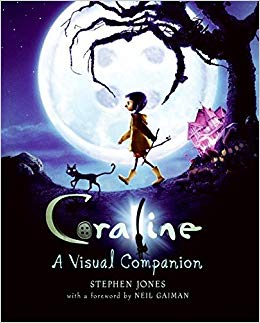 by STEPHEN JONES (William Morrow). It’s a profusely illustrated hardcover volume about the making of the film, and just as you’d expect: trite, studio-approved and pitched at a 10-year-old reading level. Jones gives us a brief history of the Neil Gaiman source book, which the author initially conceived as a lark to please his children only to have it become one of his best-loved works. Henry Selick then spent several years developing it for the screen, ending up with the most ambitious claymation film ever.
by STEPHEN JONES (William Morrow). It’s a profusely illustrated hardcover volume about the making of the film, and just as you’d expect: trite, studio-approved and pitched at a 10-year-old reading level. Jones gives us a brief history of the Neil Gaiman source book, which the author initially conceived as a lark to please his children only to have it become one of his best-loved works. Henry Selick then spent several years developing it for the screen, ending up with the most ambitious claymation film ever.
There are tons of interviews with the film’s principal creators, who offer the requisite praise for the project and their fellow collaborators, all of whom were apparently united in their incredible passion, dedication and hard work (this is the only place you’re likely to find the acting of Terry Hatcher described as “absolutely amazing”). The most interesting section comes at the end, when Jones looks at other adaptations of Gaiman’s text, including a graphic novel by P. Craig Russell and a stage production with puppets. Otherwise, though, you can safely skip this book in favor of the DVD extras.
GHOSTLY TALES OF ROUTE 66: ARKANSAS TO ARIZONA by CONNIE WILSON (Quixote Press) is a collection of fact-based ghost stories from various parts of the legendary Route 66, situated between Arkansas and Arizona. The approach is quite unique, combining a personal travelogue (complete with photos of the author at many of the locations cited) with a historical and folkloric compendium.
The book commences with a quick history of the “Mother Road,” a highway that began with the Fort Smith to California Road and culminated in Route 66. Included are accounts of Isaac Parker, the hanging judge of Fort Smith, Arkansas; Oklahoma’s Fort El Reno, a military depot where several ghosts apparently reside; and the Cadillac Ranch of Amarillo, Texas, where the apparition of an Indian boy is said to be afoot.
Whether you buy into the author’s claims of ghostly presences or not, GHOSTS OF ROUTE 66 is an enjoyable trip down one of America’s most iconic routes.
 Those of you in the under-twenty set may not fully recall of the April 1999 massacre at Columbine High School in Littleton, CO, and the incredible impact the event had on American culture. As one who researched the case extensively and published several articles on it, the new book COLUMBINE by DAVE CULLIN (Twelve), published on the tenth anniversary of the bloodbath, was quite a bombshell.
Those of you in the under-twenty set may not fully recall of the April 1999 massacre at Columbine High School in Littleton, CO, and the incredible impact the event had on American culture. As one who researched the case extensively and published several articles on it, the new book COLUMBINE by DAVE CULLIN (Twelve), published on the tenth anniversary of the bloodbath, was quite a bombshell.
Cullin was one of the first journalists on the scene of the massacre and has been studying the case ever since. His conclusions, laid out in this book, directly contradict nearly everything we thought we knew about the Columbine shootout. For one thing, the shooters, teenage Eric Harris and Dylan Klebold, were not the social outcasts they’ve been portrayed as, and nor were they obsessed with violent video games. As elucidated by Cullin, the truth was far scarier: Eric Harris was a psychopath and Klebold a depressed follower who all-too-readily fell under Harris’ dangerous spell.
Other popular myths Dave Cullin deflates: that Klebold and Harris were part of a “Trenchcoat Mafia” (such a “Mafia” existed but they weren’t in on it) and that a girl professed her faith prior to being shot (which eyewitnesses deny). Naturally this book has caused a fair amount of controversy, which is to its credit. Bottom line: if you have any interest in the Columbine massacre than you simply MUST read COLUMBINE!
Finally…
I’m unsure in what category to put THE RED BOOK by CARL JUNG (W.W. Norton & Company). It’s a massive hardcover consisting of text and pictures drafted by the late Carl Jung back in the 1940s, based on a series of dreams and visions Jung experienced as a young man. The artwork has a bold, primitive quality, not unlike pages from a medieval manuscript, while the text, presented in its original German language with English translations contained at the end of the book, is as dense and confounding as nearly anything I’ve read.
I’ll confess I haven’t read the whole thing cover to cover, but then I don’t believe there are too many people who have. It’s a difficult book, to say the least, a minutely described succession of abstract visions akin to surrealism. The difference, of course, is that surrealism isn’t supposed to be understood, whereas Jung’s every phrase has a very specific meaning…but it’s left entirely up to the reader to figure it all out.
Looking Ahead to ‘10
The new year definitely looks promising.
Forthcoming is the novel HORNS by JOE HILL, which I’ve read and admired. It arrives in February, as does A DARK MATTER by PETER STRAUB, and the “Weird Western” BLACK HILLS by DAN SIMMONS. The following month will see the long-awaited bow of WILLIAM PETER BLATTY’S new novel DIMITER and the mass market edition of the above-mentioned CREATURES OF THE POOL by RAMSEY CAMPBELL.
Other interesting-looking 2010 releases include the Creation Books publication DREAM SPECTRES, a compilation of extreme Japanese art from the 19th Century with text by JACK HUNTER; the HARRISON HOWE edited anthology DARKNESS ON THE EDGE, consisting of horror stories inspired by Bruce Springsteen tunes(!); and VIATOR PLUS, a new collection by the inimitable LUCIUS SHEPARD.
Yes, I’ll definitely be checking out these and many more books in 2010. Here’s hoping you do too, although you should still seek out the worthy 2009 publications outlined above (if you haven’t already). There were some strong books printed in the past year, as I think this article demonstrates–do look ahead, but don’t let that stop you from sampling the goodness of what came before.
